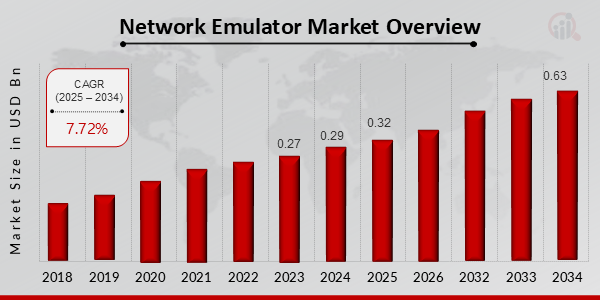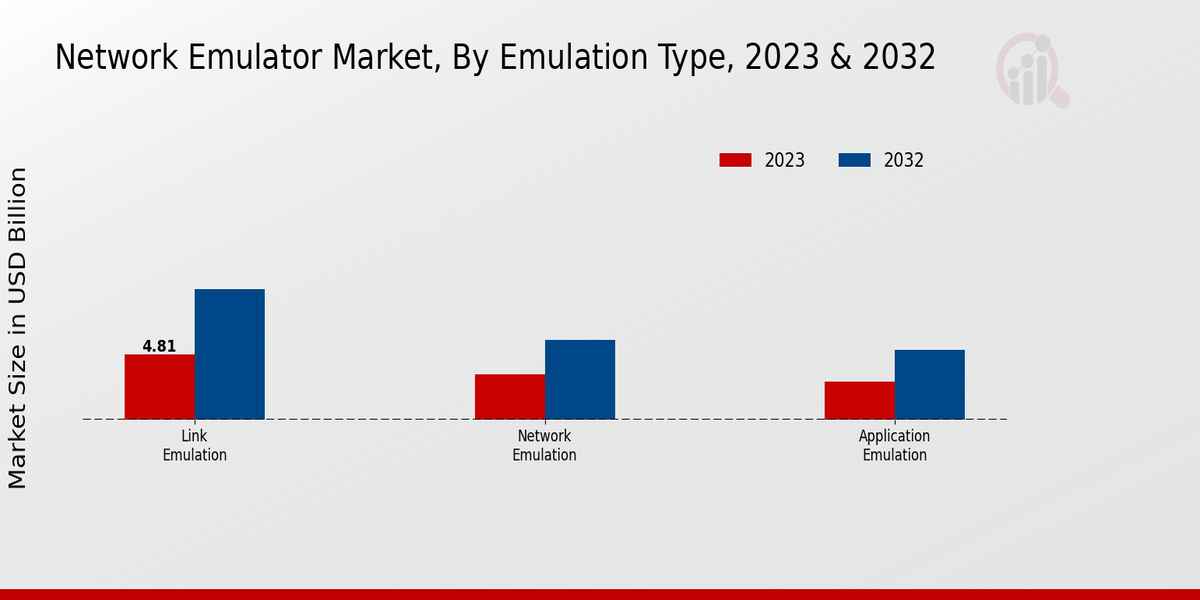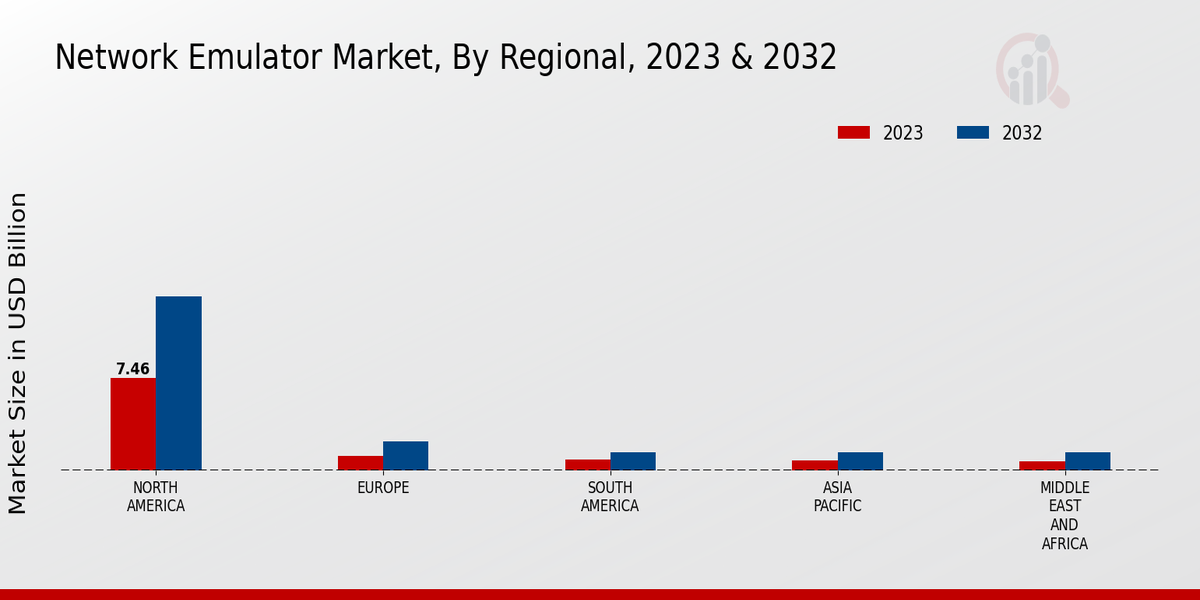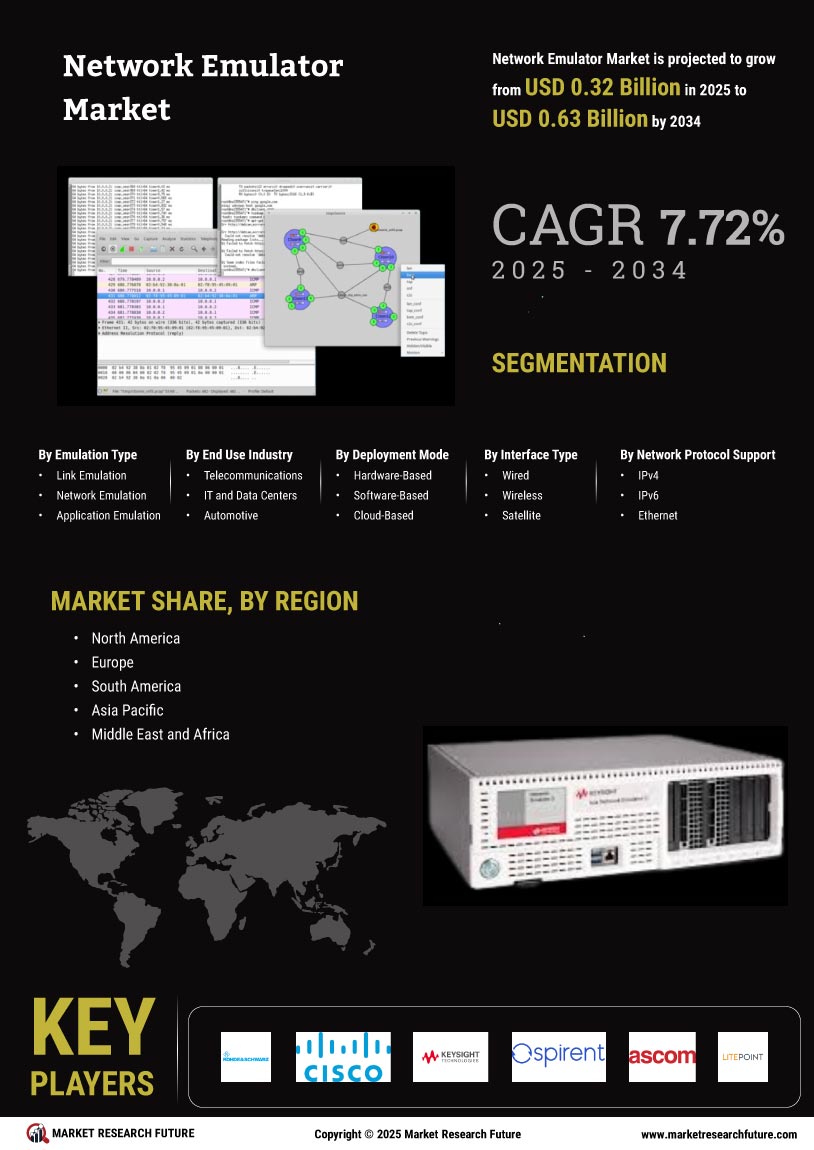Network Emulator Market Overview
Network Emulator Market is projected to grow from USD 0.32 Billion in 2025 to USD 0.63 Billion by 2034, exhibiting a compound annual growth rate (CAGR) of 7.72% during the forecast period (2025 - 2034). Additionally, the market size for Network Emulator Market was valued at USD 0.29 billion in 2024.
Key Network Emulator Market Trends Highlighted
The Network Emulator Market is continuously evolving, driven by a confluence of factors. Key market drivers include the increasing adoption of cloud and virtualization technologies, rapid network expansion, and growing demand for network security and performance monitoring. Emerging opportunities in the Network Emulator Market stem from the proliferation of 5G and IoT devices, driving the need for advanced network emulation solutions. Additionally, the rise of software-defined networks (SDNs) and network function virtualization (NFV) presents growth potential as emulators play a crucial role in testing and validating these technologies.
Recent trends in the Network Emulator Market include the adoption of cloud-based emulation platforms, providing flexibility and scalability. AI-powered emulation solutions are also gaining traction, automating testing processes and enhancing accuracy. Furthermore, the convergence of emulation and simulation technologies offers comprehensive network testing capabilities, driving market growth.
Figure1:Network Emulator Market Overview 2025-2034 (USD Billion)

Source: Primary Research, Secondary Research, MRFR Database and Analyst Review
Network Emulator Market Drivers
Rising Adoption of Cloud and Virtualization Technologies
The increasing adoption of cloud and virtualization technologies is a major driver of the Network Emulator Market Industry. Cloud computing enables businesses to access computing resources, storage, and applications over the internet, while virtualization allows multiple operating systems and applications to run on a single physical server. Network emulators play a crucial role in testing and validating the performance and functionality of cloud and virtualized environments.
By simulating real-world network conditions, network emulators help businesses ensure that their applications and services will perform as expected in a cloud or virtualized environment. The growing adoption of these technologies is expected to continue to drive the demand for network emulators in the coming years.
Increasing Complexity of Network Architectures
The increasing complexity of network architectures is another key driver of the Network Emulator Market Industry. The proliferation of mobile devices, the growth of the Internet of Things (IoT), and the adoption of new technologies such as software-defined networking (SDN) and network function virtualization (NFV) are all contributing to the complexity of network architectures. This complexity makes it more difficult to test and validate the performance and functionality of networks. Network emulators provide a cost-effective and efficient way to test and validate complex network architectures without the need for expensive and time-consuming physical testing.
Growing Need for Security Testing
The growing need for security testing is a third major driver of the Network Emulator Market Industry. The increasing number of cyberattacks and data breaches has made it more important than ever for businesses to test the security of their networks. Network emulators can be used to simulate cyberattacks and test the effectiveness of security controls. This helps businesses to identify and fix vulnerabilities before they can be exploited by attackers.
Network Emulator Market Segment Insights
Network Emulator Market Emulation Type Insights
The Network Emulator Market segmentation by Emulation Type comprises Link Emulation, Network Emulation, and Application Emulation. Among these, Link Emulation accounted for the largest revenue share in 2023, and it is projected to maintain its dominance throughout the forecast period. The growth of this segment can be attributed to the increasing adoption of network virtualization and software-defined networking (SDN) technologies. Network Emulation is expected to witness the highest CAGR during the forecast period. This growth can be attributed to the rising demand for testing and validating complex network infrastructures.
Application Emulation is also expected to grow at a significant pace during the forecast period, owing to the increasing adoption of cloud computing and mobile applications. The market growth is attributed to the increasing adoption of network virtualization and cloud computing, the rising demand for testing and validating complex network infrastructures, and the growing need for application emulation.
Figure2: Network Emulator Market, By Emulation Type, 2023 & 2032 (USD billion)

Source: Primary Research, Secondary Research, MRFR Database and Analyst Review
Network Emulator Market End-Use Industry Insights
The end-use industry segment plays a crucial role in shaping the Network Emulator Market, with each industry having distinct requirements and driving factors. In 2023, the telecommunications industry held the largest revenue share, driven by the increasing adoption of 5G networks and the need for real-time network testing. The IT and data centers segment is expected to witness significant growth, fueled by the rising demand for cloud-based services and the proliferation of data-intensive applications. The automotive industry is also expected to contribute to the market growth due to the integration of advanced driver assistance systems (ADAS) and autonomous driving technologies.
The aerospace and defense industry requires reliable and secure networks for mission-critical operations, leading to increased adoption of network emulators. The manufacturing industry is also leveraging network emulators to optimize production processes and enhance efficiency. By understanding the specific needs and growth drivers of each end-use industry, market players can tailor their strategies and solutions to meet the evolving demands of the Network Emulator Market.
Network Emulator Market Deployment Mode Insights
The Network Emulator Market is segmented based on Deployment Mode into Hardware-Based, Software-Based, and Cloud-Based. Among these segments, the Hardware-Based segment held the largest market share in 2023 and is expected to continue its dominance throughout the forecast period. The growth of this segment can be attributed to the increasing adoption of hardware-based network emulators by enterprises and service providers to simulate complex network environments and test the performance of network devices and applications. However, the Software-Based segment is anticipated to witness significant growth during the forecast period due to the growing popularity of software-defined networking (SDN) and network function virtualization (NFV) technologies. Cloud-based deployment mode is expected to gain traction in the coming years as more and more enterprises move their applications and services to the cloud.
Network Emulator Market Interface Type Insights
The Network Emulator Market is segmented by Interface Type into Wired, Wireless, and Satellite. Wired Network Emulators are expected to hold the largest market share in 2023. The growth of this segment can be attributed to the increasing adoption of wired networks in enterprises and data centers. The Wired Network Emulators market is expected to reach a value of USD 5.77 billion by 2032, growing at a CAGR of 7.6%. The Wireless Network Emulators market is expected to grow at a CAGR of 8.2% during the forecast period. The growth of this segment can be attributed to the increasing adoption of wireless networks in various applications, such as mobile communication, IoT, and smart cities.
The Wireless Network Emulators market is expected to reach a value of USD 8.21 billion by 2032. The Satellite Network Emulators market is expected to grow at a CAGR of 9.1% during the forecast period. The growth of this segment can be attributed to the increasing adoption of satellite networks in various applications, such as remote sensing, disaster management, and military communication. The Satellite Network Emulators market is expected to reach a value of USD 4.12 billion by 2032.
Network Emulator Market Network Protocol Support Insights
Network protocol support, a pivotal aspect of network emulation, enables testing and validation of network devices, applications, and services across diverse protocol stacks. IPv4, a widely adopted protocol, holds a significant share in the network protocol support segment. IPv6, its successor with enhanced capabilities, is gaining traction driven by the proliferation of IoT devices and the need for more IP addresses. Ethernet, a dominant protocol in LANs, is expected to maintain its strong position due to its simplicity, reliability, and scalability.
MPLS, a versatile protocol for traffic engineering and VPN services, is projected to witness notable growth owing to its ability to prioritize and manage network traffic efficiently. SDN, an innovative protocol, empowers network programmability and control, offering greater flexibility and automation in network management, thus driving market growth.
Network Emulator Market Regional Insights
The regional analysis of the Network Emulator Market showcases distinct market dynamics across key geographies. North America held the largest market share in 2023, driven by the high adoption of advanced technologies and the presence of major industry players. The region is expected to maintain its dominance throughout the forecast period, with a projected market value of USD 6.32 billion by 2032, exhibiting a CAGR of 6.8%. Europe follows North America, with a significant market share attributed to government initiatives and growing demand for network testing and optimization.
The Asia-Pacific region is anticipated to witness the fastest growth over the forecast period, owing to rapid urbanization, increasing mobile device penetration, and expanding IT infrastructure. The region is projected to reach a market value of USD 5.21 billion by 2032, exhibiting a CAGR of 8.1%. South America and MEA regions are expected to grow steadily, supported by increasing investments in network infrastructure and rising demand for network performance monitoring.
Figure3: Network Emulator Market, By Regional, 2023 & 2032 (USD billion)

Source: Primary Research, Secondary Research, MRFR Database and Analyst Review
Network Emulator Market Key Players And Competitive Insights
Major players in the Network Emulator Market industry are continuously developing and launching new products to gain a competitive edge. Leading Network Emulator Market players are focusing on providing innovative solutions that meet the evolving needs of their customers. The Network Emulator Market is expected to witness significant development in the coming years, driven by the growing adoption of cloud and virtualization technologies. The competitive landscape of the Network Emulator Market is expected to remain competitive, with a number of key players vying for market share.
One of the leading competitors in the Network Emulator Market is Ixia. Ixia offers a wide range of network emulation solutions that enable customers to test and validate the performance of their networks. Ixia's products are used by a variety of customers, including telecommunications service providers, enterprise networks, and government agencies. Ixia has a strong track record of innovation and has been a pioneer in the development of network emulation technology.
Another major competitor in the Network Emulator Market is Spirent Communications. Spirent Communications offers a comprehensive portfolio of network emulation solutions that address the needs of a wide range of customers. Spirent's products are used by enterprises, service providers, and government agencies to test and validate the performance of their networks. Spirent has a long history of providing innovative network emulation solutions and is a trusted partner to many of the world's leading organizations.
Key Companies in the Network Emulator Market Include
- Rohde Schwarz
- Cisco Systems
- Keysight Technologies
- Spirent Communications
- Ascom
- LitePoint
- Aethra
- Ixia
- Certicom Systems
- Ciena
- Viavi Solutions
- Huawei
- Juniper Networks
- Nokia
- Anritsu
Network Emulator Market Industry Developments
The Network Emulator Market is projected to grow from USD 10.95 billion in 2023 to USD 20.63 billion by 2032, at a CAGR of 7.29%. Growing demand for network emulation solutions in the telecommunications sector and the increasing need for testing and validation of network devices and applications are the key factors driving the market growth.Recent developments in the market include
March 2023: Spirent Communications announced the launch of its new Landslide Network Emulator, which provides advanced network emulation capabilities for testing and validation of 5G networks.
February 2023: Anritsu Corporation introduced its new MT1000A Network Emulator, which offers high-performance emulation of real-world network conditions for testing and validating network devices and applications. Key players in the Network Emulator Market include Spirent Communications, Anritsu Corporation, Ixia Solutions, and Viavi Solutions.
Network Emulator Market Segmentation Insights
Network Emulator Market Emulation Type Outlook
- Link Emulation
- Network Emulation
- Application Emulation
Network Emulator Market End Use Industry Outlook
- Telecommunications
- IT and Data Centers
- Automotive
- Aerospace and Defense
- Manufacturing
Network Emulator Market Deployment Mode Outlook
- Hardware-Based
- Software-Based
- Cloud-Based
Network Emulator Market Interface Type Outlook
Network Emulator Market Network Protocol Support Outlook
- IPv4
- IPv6
- Ethernet
- MPLS
- SDN
Network Emulator Market Regional Outlook
- North America
- Europe
- South America
- Asia Pacific
- Middle East and Africa
|
Report Attribute/Metric
|
Details
|
|
Market Size 2024
|
0.29 (USD Billion)
|
|
Market Size 2025
|
0.32 (USD Billion)
|
|
Market Size 2034
|
0.63 (USD Billion)
|
|
Compound Annual Growth Rate (CAGR)
|
7.72% (2025 - 2034)
|
|
Report Coverage
|
Revenue Forecast, Competitive Landscape, Growth Factors, and Trends
|
|
Base Year
|
2024
|
|
Market Forecast Period
|
2025 - 2034
|
|
Historical Data
|
2019 - 2023
|
|
Market Forecast Units
|
USD Billion
|
|
Key Companies Profiled
|
Rohde Schwarz, Cisco Systems, Keysight Technologies, Spirent Communications, Ascom, LitePoint, Aethra, Ixia, Certicom Systems, Ciena, Viavi Solutions, Huawei, Juniper Networks, Nokia, Anritsu
|
|
Segments Covered
|
Emulation Type, End Use Industry, Deployment Mode, Interface Type, Network Protocol Support, Regional
|
|
Key Market Opportunities
|
Cloud-based Network Emulation 5G and LTE Network Testing Automation and Artificial Intelligence AI Cybersecurity Testing Software Defined Networking SDN Emulation
|
|
Key Market Dynamics
|
Growing network complexities Increasing virtual network deployments Rising need for testing and evaluating network solutions Demand for cost-effective troubleshooting tools Government regulations and initiatives promoting network emulation
|
|
Countries Covered
|
North America, Europe, APAC, South America, MEA
|
Frequently Asked Questions (FAQ) :
The Network Emulator Market was valued at USD 0.29 billion in 2024 and is projected to reach USD 0.63 billion by 2034, exhibiting a CAGR of 7.72% during the forecast period.
North America is expected to dominate the Network Emulator Market, owing to the presence of major technology companies and advanced network infrastructure in the region.
Network Emulators are primarily used for testing and validating network performance, simulating network environments for training and research, and developing and testing network applications.
Key players in the Network Emulator Market include Cisco Systems, Ixia, Spirent Communications, Anritsu, and Viavi Solutions.
The growth of the Network Emulator Market is attributed to the increasing demand for network testing and validation, the adoption of cloud computing and virtual network architectures, and the need for network security and performance optimization.
Challenges faced by the Network Emulator Market include the high cost of network emulation equipment, the complexity of network emulation setups, and the shortage of skilled professionals.
Recent trends in the Network Emulator Market include the emergence of cloud-based network emulation solutions, the integration of artificial intelligence and machine learning for network emulation, and the adoption of open-source network emulation platforms.
The Network Emulator Market is projected to reach USD 0.63 billion by 2034, exhibiting a CAGR of 7.72% from 2025 to 2034.
The Network Emulator Market is projected to reach USD 0.63 billion by 2034, exhibiting a CAGR of 7.72% from 2025 to 2034.
Key factors driving the growth of the Network Emulator Market include the increasing adoption of network virtualization and cloud computing, the growing need for network testing and validation, and the advancements in network technologies.

















